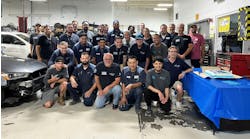But End Without Resolution
WASHINGTON (Oct. 5, 2005) - Despite much progress aimed at reaching a non-legislated solution to the Right to Repair issue (H.R. 2048), meetings chaired by the Council of Better Business Bureaus Inc. (BBB) facilitation service have ended after an extension until Sept. 30, and there is no certainty where things will go from here.
Three aftermarket organizations participated, including the Automotive Service Association (ASA), the Coalition for Auto Repair Equality (CARE) and the Automotive Aftermarket Industry Association (AAIA). The National Automobile Dealer Association (NADA), Association of International Automobile Manufacturers (AIAM) and Alliance of Automobile Manufacturers (AAM) represented automakers. The Federal Trade Commission (FTC), on behalf of Congressman Joe Barton (R-TX), was in attendance as an observer.
Steven Cole, president and CEO of the BBB said in a report to James Kohm, an associate director with the FTC, that despite 10 all-day, private aftermarket/automotive meetings that his organization had facilitated and much progress over their course, the two sides were unable to come to an agreement on some outstanding issues. He stressed that all participants had put forth a genuine and good-faith effort.
Progress to a point Cole first addressed the positives of the negotiations: "Resolution appears to have been possible on many of the core issues including strengthening and new funding of the National Automotive Service Task Force (NASTF) process; many remedies for a third-party dispute resolution framework; rigorous timeframes that would need to be observed; and dispute resolutions procedures, among other items." He told the FTC that the BBB was ready to assist in the future negotiations between the current or other parties, should the need arise.In his report, Cole listed the remaining issues that could not be overcome by the deadline. His complete list included:
1. How should NASTF be structured and governed to ensure that all interests were represented in a balanced manner?
2. How should monetary remedies in the third-party dispute resolution process be calculated, and what penalty, if any, should be assessed if a manufacturer failed to comply with a mechanism decision?
3. How tool-related issues should be handled, both by NASTF and by the third-party mechanism? Had an agreement been reached, it was the parties' intention to defer these questions to a newly restructured NASTF board.
4. How or whether possible issues of the cost of a tool would be handled by NASTF and the third-party if it was alleged that the price of the tool was so high in relation to the rest of the market that the price made the tool "unavailable" as a practical matter.
5. A mutually acceptable method to deal with issues relating to vehicle security: How to provide the aftermarket industry with the practical ability to obtain necessary information and codes to complete repairs without compromising the consumer's security. It seems that only one or a few of the auto manufacturers were unable to reach agreement on a methodology.
6. The extent to which manufacturer-supplied information through telephone hotlines should be required to be made available to independent repair facilities when it is not published in writing and sent to all franchised dealers.
Post-meeting analysis Several of the participants had comments once the meetings had concluded, which they had withheld earlier until the discussions had concluded, respecting the delicacy and goodwill for others at the table.Kathleen Schmatz, president and CEO of AAIA stated, "Although AAIA, CARE and other groups supporting H.R. 2048 remain open to the future possibility that a deal could reached, at the present time we believe that it is in the best interest of the independent aftermarket and its customers to continue to push for passage of Right to Repair legislation in order to ensure competition in the vehicle repair and service market, now and into the future."
"AAIA and CARE believe that both sides made strong efforts to reach an agreement; the positions of both groups on these issues were too far apart to be resolved," said David Parde, president of CARE. "It was our hope that we could avoid legislation, but it is clear that absent a statute, many of the vehicle manufacturers are not going to change their policies that favor new car dealers."
John Cabaniss, director of Energy and Environment for AAIM, also expressed appreciation and respect for the effort made by all, as well as disappointment that a full resolution, satisfactory to all parties, was not reached. He indicated that the governance of NASTF (Cole's first item) was the major hurdle that couldn't be resolved. Specifically, he said, "CARE insisted, and was unyielding, that under a newly constituted NASTF organization that CARE would name 50 percent of the board members and all other groups would share the other 50 percent of the board."
Many of the parties at the meetings could not agree to this, given the broad range of multiple stakeholders that need to be involved in NASTF - shop owners, technicians, automakers, trainers, tool companies, independent service information providers and locksmiths. "It is inappropriate to suggest that any one group should have 50 percent control of the board. If this issue could have been resolved, then the other NASTF-related issues could have probably been settled, too," Cabaniss added.
"We could not agree to this," said Bob Redding, ASA's Washington, DC representative. "Parts distributors are just one segment of the automotive industry. Many segments are involved in NASTF: repairers, trainers, information providers, technicians, etc. Under this formula, independent repairers would not have been included on the NASTF board."
In the wake of the ending of negotiations, the participants and Congress won't rest. Legislation in Congress was reintroduced earlier this fall, but it was put on hold in the hopes the meetings would be successful. Barton, sponsor of H.R. 2048, indicated he would push for the passing of the bill, and is on record as having told AAIA that he had enough support for it to pass. But to become law, the Senate would also have to concur. Senator Lindsey Graham (R-SC), sponsor of the companion bill in the Senate, said he would wait for the outcome of the House vote, before initiating action. Whether legislation would pass in both bodies remains uncertain.
Automakers, NADA, AAM and AIAM will continue to oppose legislation, will lobby to that effect and will continue to try to move forward with the voluntary solution already in place via NASTF. Cabaniss summarized the position of those opposed to legislation: "Further legislation and regulations will likely not resolve any of the purported issues raised by proponents of the bill, such as cost of Web site access, occasional content errors, etc. However, government intervention will almost certainly take resources away from resolving problems to focus on the regulatory process, leading to delays in real progress. This is not good for anyone - not shops, not consumers and not automakers. We need results, not rhetoric. And NASTF would be even more successful if all interested parties would put aside its parochial interests and support NASTF in making it more effective."
Some aftermarket associations, such as AAIA and CARE, will ramp up efforts to press for a legislated solution. Lobbying by them also will continue, as will efforts to have member businesses and employees of those businesses e-mail or write their representatives in Washington. "While a great deal of progress was made during the negotiations, critical issues that could impact the future viability of the agreement and the ability of independent shops to repair late-model, highly sophisticated vehicle systems remain unresolved," said Schmatz.
Other aftermarket associations, however, such as ASA and the Associated Locksmiths of America (ALOA) remain opposed to pending legislation, preferring instead to work within the cooperative structure that NASTF has fostered to date. ALOA had committed before this round of talks began to work towards the design and implementation of a system to address consumer's vehicle security that wouldn't compromise consumers, a topic that will be discussed at the November NASTF meeting in Las Vegas.
Redding echoed ASA's position of working toward a non-legislative solution: "This was an opportunity to achieve this type of solution. We were willing to continue talking on September 30 and remain open to a dialogue on this issue."
Creating a permanent structureIn another development, the Equipment and Tool Institute (ETI) recently sent NASTF a proposal aimed at formalizing NASTF into a working group over a three-year trial period. ETI is unique among the industry participants in that it is neither an aftermarket nor an automaker association, but has important customers in both segments.
"NASTF has been a success," said Redding. "This process [the recent talks] illustrated the necessity for a full-time NASTF staff and formal structure."
When contacted about the ETI proposal, Cabaniss told Motor Age the proposal was being considered. As for now, it was business as usual. Work is continuing through the various NASTF committees on service information, training, tools and vehicle security. In addition, NASTF continues to welcome suggestions and will inform automakers about Web site user feedback to improve their service information Web sites.
When asked about the end of the meetings, he urged technicians, shops and related businesses to continue supporting NASTF: "Make sure your friends, colleagues and co-workers know about NASTF and what it is doing to ensure access to service information, training and tools for all technicians. And if your have a problem, let us know so we can address it."
With Industry Week fast approaching and all the participants there, the November NASTF meeting and other discussions in and around Las Vegas should be lively. While negotiations have been suspended for the time being, politics, economics and grassroots pressure may lead to their resumption. As Cole said, the genuine progress that did occur in the meetings demonstrated that all parties could respect, talk to each other and bridge differences.
It is real dialogue that enabled that. Let us hope someone finds a way to reignite more of it.
(Sources: AAIA, AIAM, ETI, CARE, NASTF)


